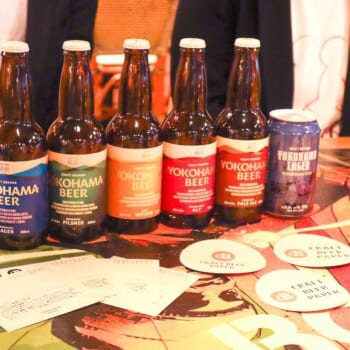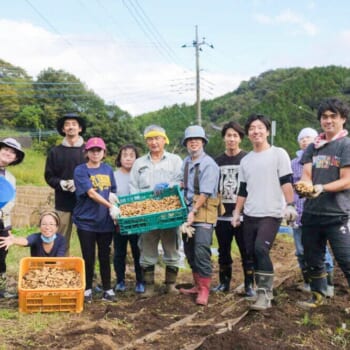![What post-COVID-19 world look like? Circular Economy Plus clear up the new demands in Ryokuen [Experience Report]](https://circular.yokohama/wp-content/uploads/2021/05/FBxDJiOA.jpeg)
What post-COVID-19 world look like? Circular Economy Plus clear up the new demands in Ryokuen [Experience Report]
- On 2021/11/18
Since the COVID-19 came into the world, the way we work has been dynamically changing. Many people work from home, hold their meetings online, and many new words that symbolize the change of our lifestyle has been created, such as self-isolation, quarantine, key-workers, and so on. Now, another question came up; how will the way we work and live look in the post-COVID-19 world?
In terms of the circular economy, work style diversity is one of the essential factors as well. In the concept of Yokohama’s circular economy, “Circular Economy Plus,” work style diversity is referred to as “Parallel careers.”
Why “parallel careers” is necessary? It is because the economy system changes the companies, companies change our societies, and our communities change each of our work styles eventually.
For this reason, We, Circular Yokohama, collaborated with the Ryokuen Living Lab based in Izumi-Ku, Yokohama-City. On February 13, 2021, we held a fieldwork session on the theme of “New Ways of Working in the Circular Society.”
Let’s think about the ciry of Ryokuen’s local issues in terms of our new life style and find solutions.
*This event is part of Circular Economy Plus School, which is organized by Circular Yokohama in collaboration with the YOKOHAMA Living Lab Support Office and the NPO Yokohama Community Design Lab.
What is Ryokuen Living Lab?
Ryokuen Living Lab is a living lab that promotes diverse and inclusive work and lifestyles in the community.
Miyuki Nomura, the chief of Ryokuen Living Lab, focuses on supporting women who raise their children and work simultaneously.
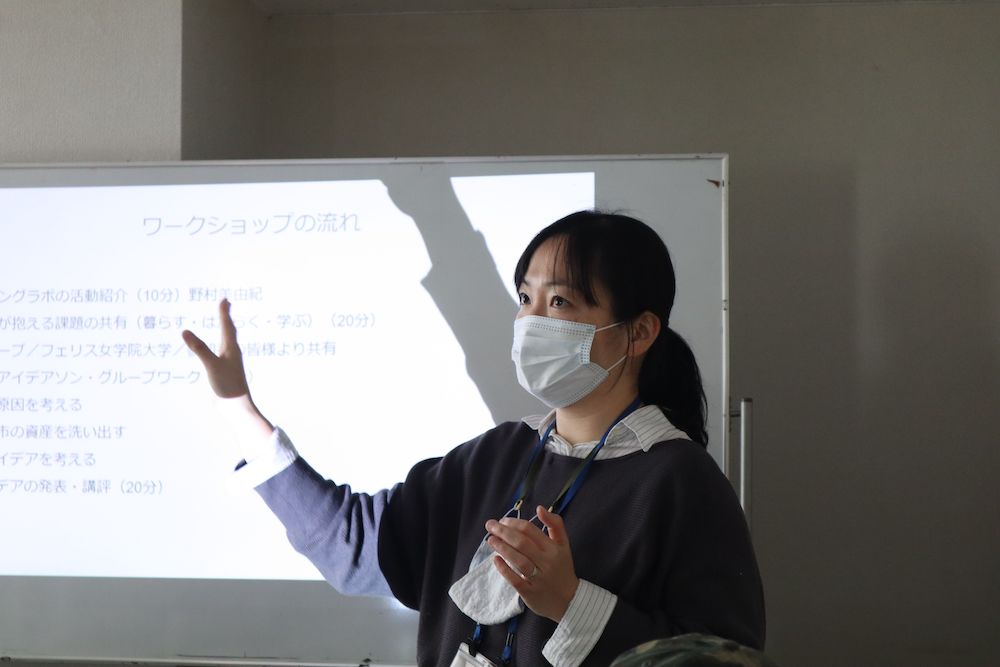
Mrs. Nomura
In this pandemic, she has been developing new activities such as “YOKOHAMA Gauze Mask Ships,” a project to handmade face masks by women all over Japan play, and online seminars to support students looking for a job.
Walk through Ryokuen
At this time, our goal was to find possible solutions to the social issues that Ryokuen confront from the perspective of the circular economy and parallel carriers.
The day of the event was blessed with fine weather. A total of 16 participants gathered at Sotetsu line Ryokuen Toshi Station. We had participants of different ages and have various backgrounds, including those who are working and learning in Ryokuen.

After each self-introduction at Ryokuen Toshi Station, Mrs. Nomura led us to walk through Ryokuen.
In the late Showa period(around 1950s), when Ryokuen was in the middle of development, people thought the quality of life would be better if the place where they lived and worked were apart. For this reason, Ryokuen developed as a so-called “bedroom town.” Later, however, as time went by in the Heisei and the Reiwa period, people’s working and living styles became more diverse, and the town’s population has been aging at the same time. Those situations have been said to be crucial issues in the town.
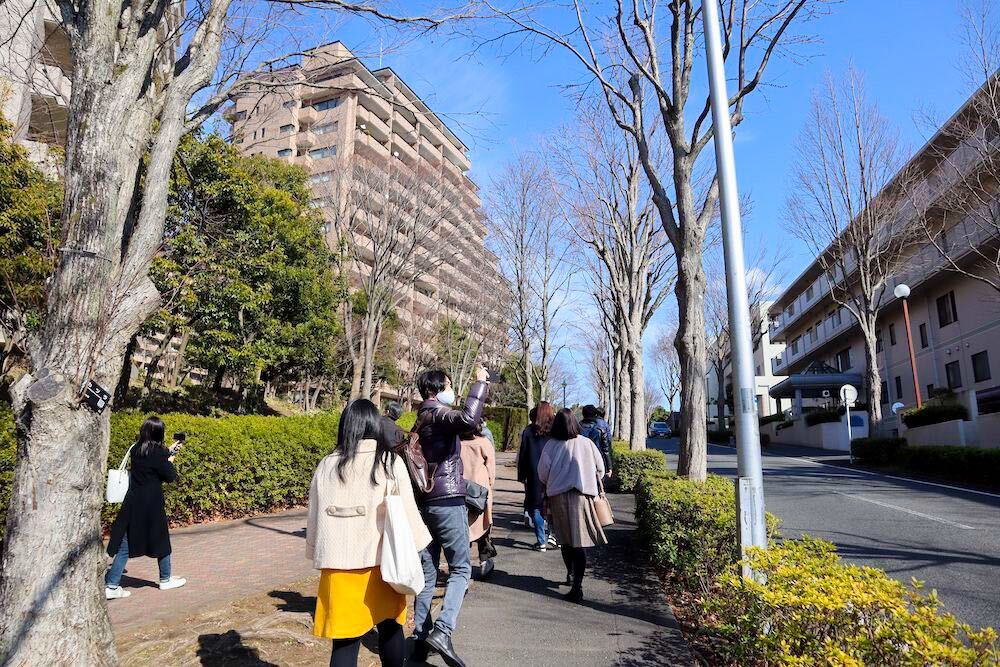
In addition, Mrs. Nomura said, the COVID-19 has brought another social issue to Ryokuen.
“As people started working and studying remotely, we have noticed that there were not enough space and place to gather, work and study in the town because the town used to be just a place where people came back to sleep at night. People used to spend time in the city on weekends, but they now need to spend time within the community due to travel restrictions. There are only a few cafes and restaurants in town where people can work and study, or a place to enjoy leisure activities in their free time. We have realized that the role of the town has been changing.”
The pandemic has created a new demand for the town. Ryokuen Living Lab works more closely with local residents and companies to develop a city that meets unique needs.
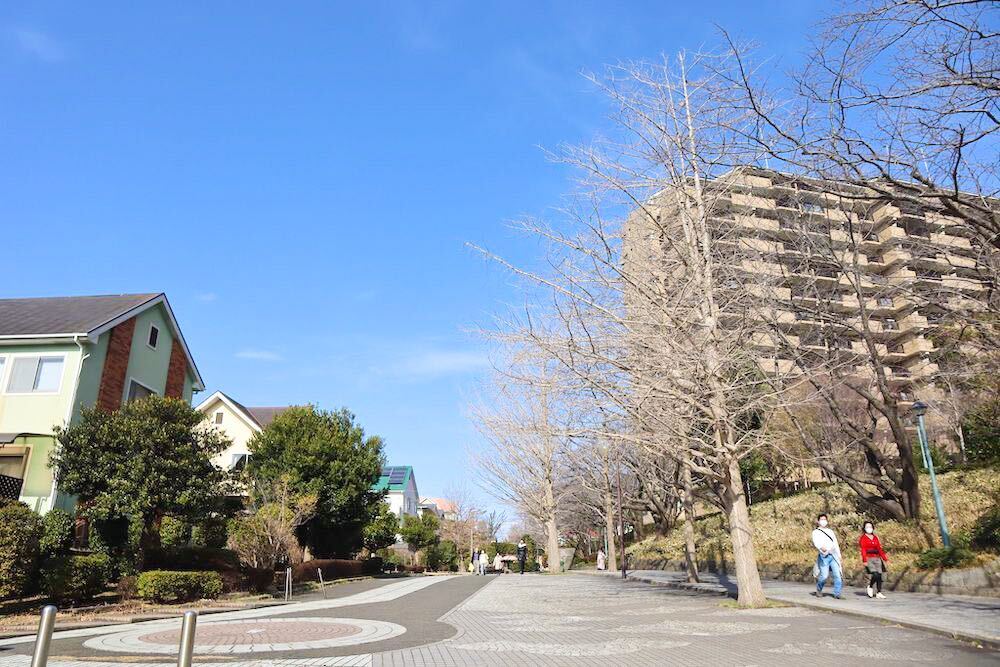
The promenade is also known as a filming location for movies and TV dramas. It is for pedestrians only, so you can enjoy walking or running without worry.
An ideathon to find solutions to local issues in Ryokuen
After the walk around the town, we had a discussion to come up with ideas to solve the issues Ryokuen faces.
First, the participants divided the situation they saw in the town into three areas: study, work, and living, and identified possible causes and solutions.
The participants wrote down their findings on bullet points. Mrs. Nomura gave a supplementary explanation of the city’s history during the discussion.
Next, the participants were divided into three groups (learning, working, and living) to discuss solutions to each theme from a circular perspective.

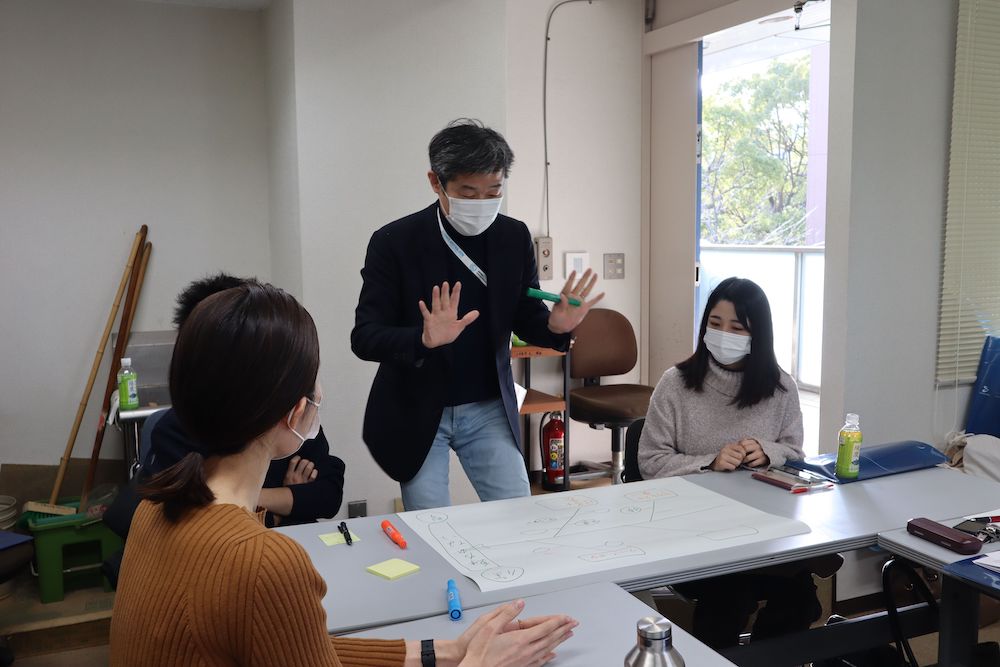
After the discussion, each group presented their ideas.
The “study” team’s discussion led students who are studying at a university and a middle school in Ryokuen. They came up with the idea of establishing a facility where people of various ages can gather.

In the morning, the facility will be used mainly by the elderly to hold workshops. In the afternoon and evening, it would be a space for students to study and relax, and in the evening, the area provides adults to dine after work. In this way, the space will be used effectively, and interaction beyond the generation and ages would be encouraged.
The next team, which discussed “work,” presented a new town model to connect people inside and outside the city by inviting young entrepreneurs.
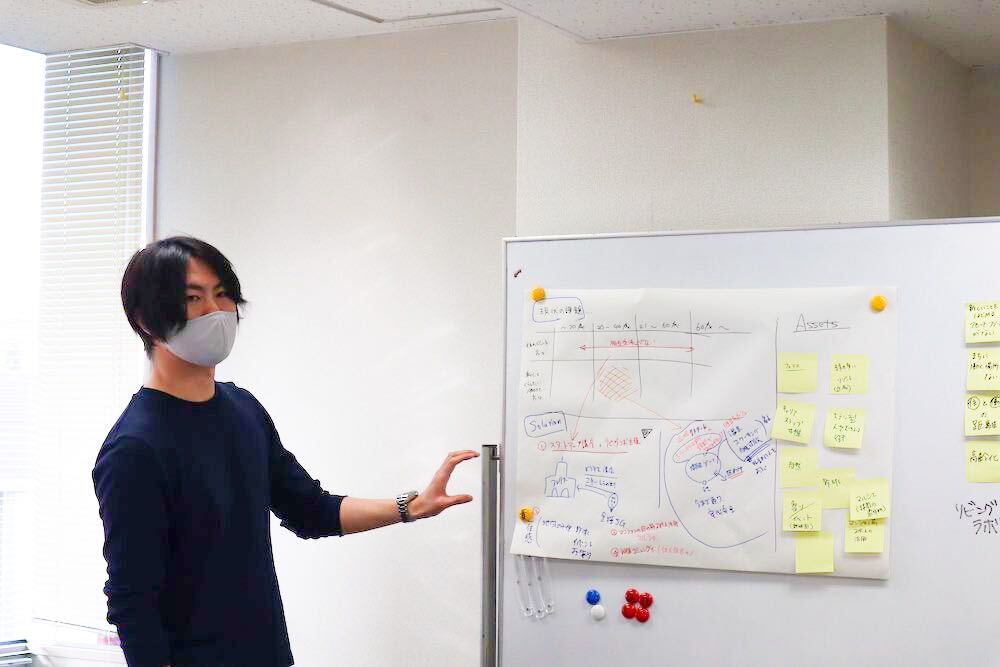
For example, start-up companies could provide business courses to students at a University. People inside the city would take in new technology and knowledge, and entrepreneurs would make their money and accelerate the local economy.
Additionally, by opening up the town’s public spaces, such as cafes, hot spring facilities, as co-working spaces, people outside the town could enjoy the Ryokuen community as well. It is an excellent form of community development that benefits people both inside and outside the town.
Lastly, the team that discussed “living” came up with the idea of how the town could take its history to future development.
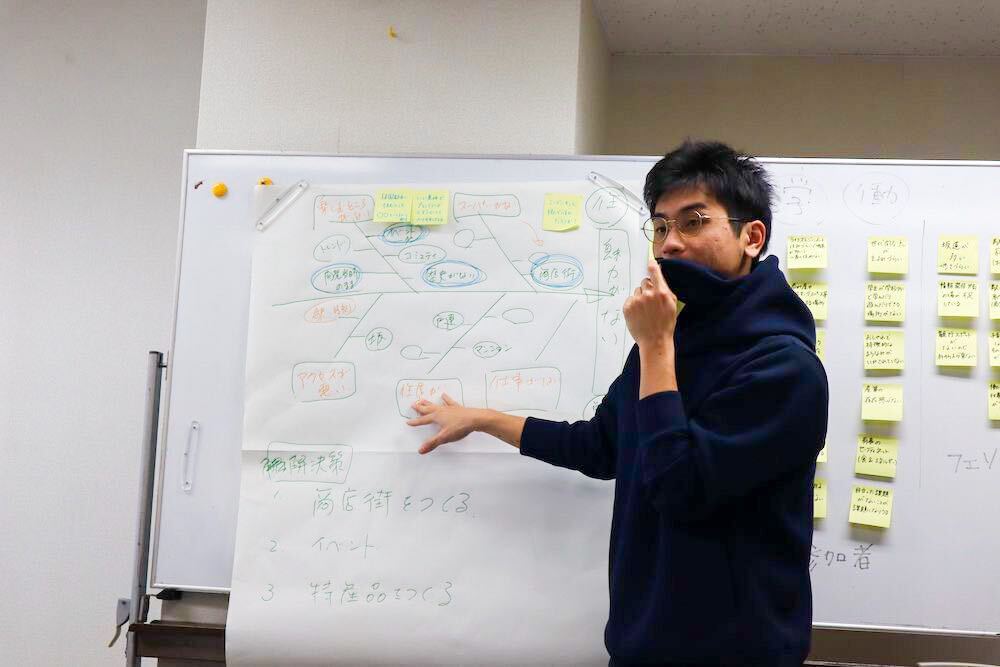
They identified the elements that Ryokuen did not have and clarified what is needed now and future. The proposal was to create a shopping district, hold events constantly, and produce local limited products and merchandise to build good connections and vitality in the entire town.
At the end of the event, Mrs. Nomura thanked the participants for their presentations, saying, “It is precious to have the opportunity to carefully consider our local issues from the perspective of people outside the town .”
The event was wrapped up with the hope that the proposal would be reflected in future city planning through the Ryokuen Living Lab and companies involved in city planning.
Editor’s Note
“In the past, people thought the quality of life would be better if the place where they lived and worked were apart, but this pandemic has changed our lifestyle a lot.”
In the post-COVID-19 world, the new way of living requires both living and working functions in one area. This is not just the issue Ryokuen faces but other towns and cities potentially face as well.
“Local production for local consumption,” “local circulation,” and “local economy” are the keywords of the circular economy. Ryokuen is currently seeking to incorporate those keywords into its city development to realize an ideal lifestyle that fulfills the happiness of a diverse range of people.
We hope you find some hints and take them to make your area circular.
室井梨那(Rina Muroi)
Latest posts by 室井梨那(Rina Muroi) (see all)
- Yokohama Leads Asia as First Signatory of the Asian Circular Cities Declaration at ASCC 2025 - 2025/11/27
- Minato Mirai Circular City Project: Co-creating a Decarbonized Future in Yokohama - 2025/11/7
- Circular Hospitality in Action: Yokohama Bay Sheraton’s Approach to Food and Energy Cycles - 2025/9/29


![Think about the future of Yokohama with Donut Economics [Experience Report]](https://circular.yokohama/wp-content/uploads/2021/06/Image-from-iOS-64-300x235.jpg)
![Can DX be a solution to the problem with plastic containers? [Experience Report]](https://circular.yokohama/wp-content/uploads/2021/05/shutterstock_525066214-300x200.jpg)
![How can we make a business more sustainable? Find out the way with haishop [Experience Report]](https://circular.yokohama/wp-content/uploads/2021/05/Image-from-iOS-48-300x200.jpg)
![Yokohama local plastic waste turns out to be a unique asset [Experience Report]](https://circular.yokohama/wp-content/uploads/2021/05/159009092_4137153702984581_8946275429530827838_n-300x200.jpeg)
